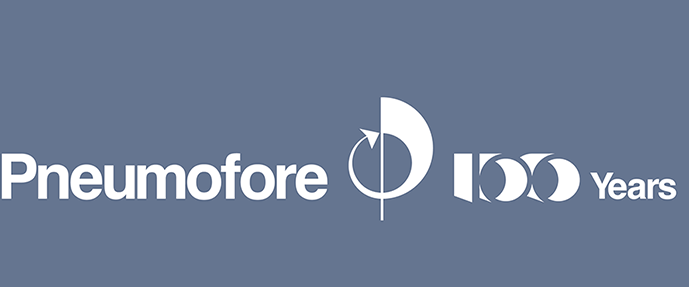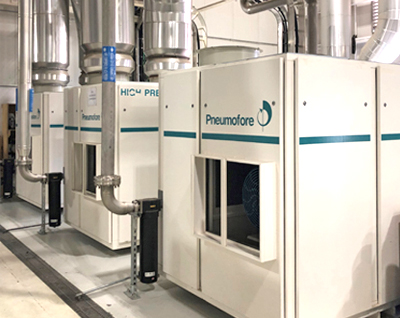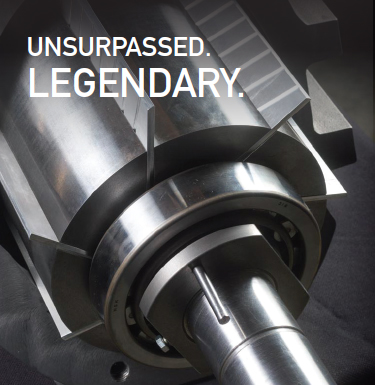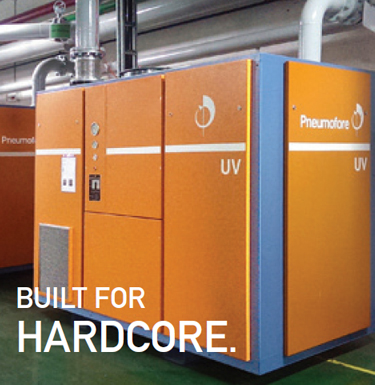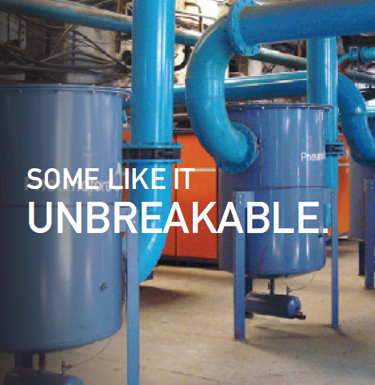Exemplary Vacuum and Compressors Setup for Envases Universales
At the Pachuca plant of Envases Universales, near Mexico City, Pneumofore supplied in 2019 the pneumatic machinery and engineering. Three separate pressure systems for vacuum, low- and high-pressure are installed with remarkable results, measurable now after 3 years of continuous operation.
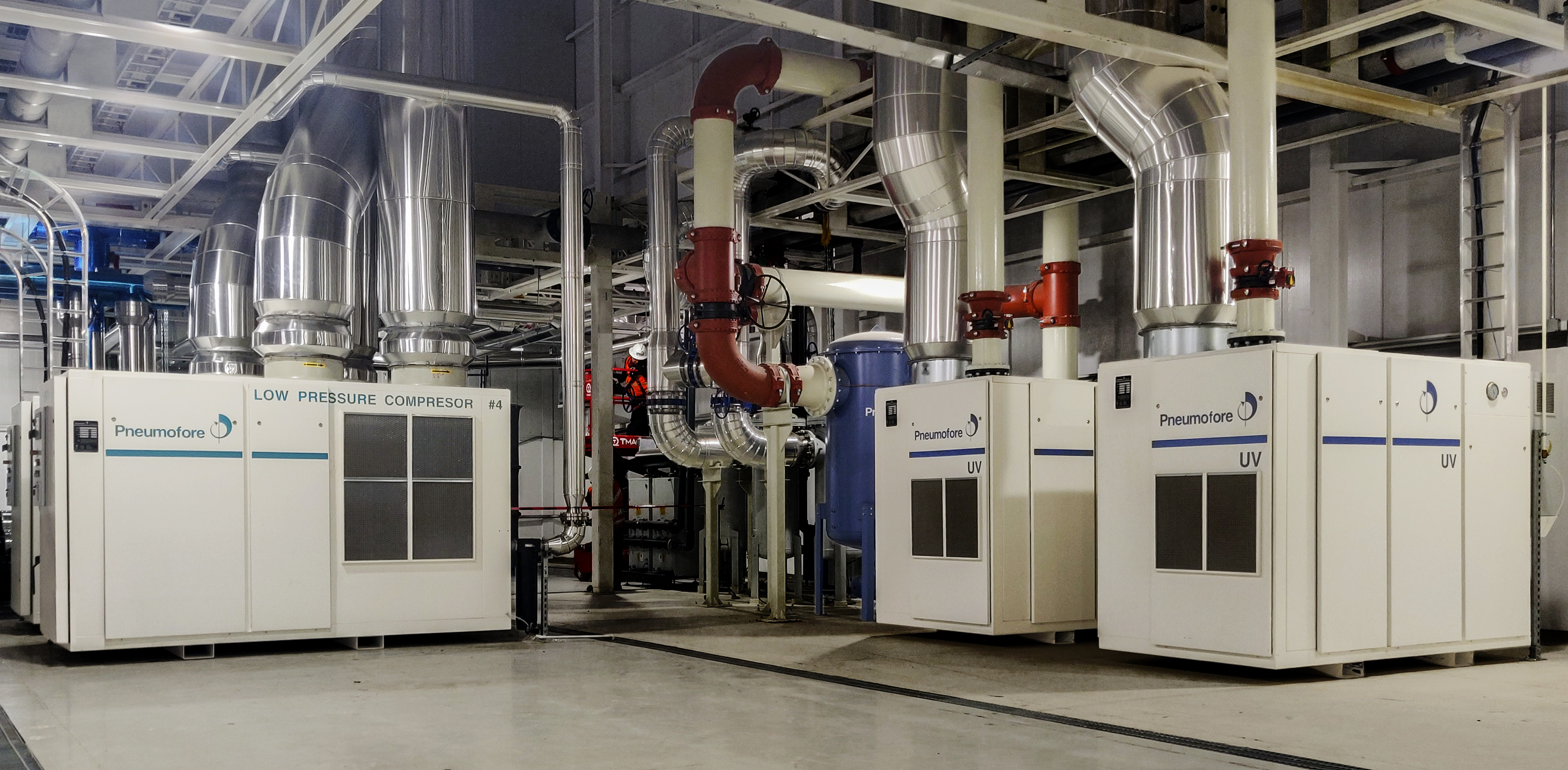
Pneumofore 4 bar(g) A Series Compressors and UV Vacuum Pumps at Envases Universales in Pachuca
Dealing with ambient air warrants consideration of the humidity, the temperature, and the pressure at the installation site. Being at an altitude of 2.432 meters, the extraordinary situation in Pachuca requires attention only to the pressure. The air is ‘thinner’ due to the reduced ambient pressure. The cooling system on board of every vacuum pump and air compressor is dimensioned to cope with this altitude-related challenge, larger coolers and stronger fans are installed. The ventilation of the compressor room, as well as the evacuation of hot air, requires engineering work with calculations of ducts length, size, layout, and the necessary fans.
The initial decision to divide into 3 pressure lines has proven to be the most appropriate solution. The low-pressure loop is served by dedicated low pressure compressors, which perform at their best efficiency being designed to run at the low pressure of 4 bar(g). There is more nominal compressor’s power installed for the low-pressure than for the high-pressure loop. The third pressure line is dedicated to vacuum.
The usual installation of 2 pressure lines only, one for compressed air and one for vacuum, and the use of pressure reducers to match the different compressed air pressure levels required in production, seems to be a simpler solution, but it is very costly to operate. Basically, there is no need to compress up to 8 bar(g) if the required pressure is 4 bar(g), half the work is wasted. Compressors are energy intense machines which merit the same careful attention in selection and installation for long-term economic operation, as required by 2-piece can factories.
Machines alone do not make up the entire pneumatic system. The setup of the 3 different pressure lines follows pipe and duct calculations to optimize system performance. Pipeline length and receivers are integral parts of the system. Often, dryers are installed to discharge all the condensed humidity. At Pachuca, the entire system was calculated, designed, and installed with reasonable dimensional safety criteria, to contain the costs, whilst yielding the best all-over performance.
‘Performance over time’ was the initial requirement, this is how Pneumofore succeeded in this project. The machine performance is constant over more than 120.000 hours without overhauling. Ordinary maintenance is performed once per year. With regular service and the use of original consumables, the rotary vane machines of Pneumofore have maintained the same initial performance, in the 3 years since the installation date.
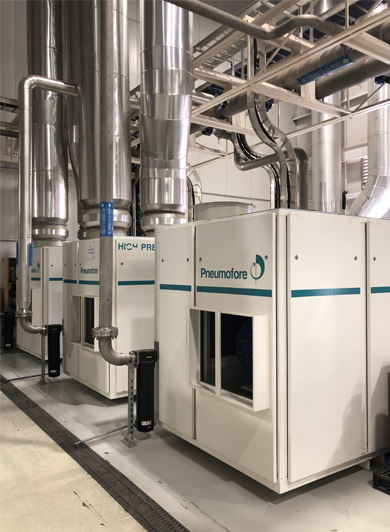
This result is remarkable due to the 3,77 total installed MW of electrical power. With the Mexican industrial electrical rate of 0,1 US$ for 1 kWh, with all machines running, the generated electrical power cost is 3,3 million US$, almost 10 million US$ since installation. This value is way higher than the machine cost at purchase. The good thing is that the performance has remained as new, no sudden costs have appeared, no further costs other than ordinary service are foreseen for the next 10 years. The electrical bill for the compressors and vacuum pumps is the largest expense to run the can factory, besides the raw material expense for production. A loss of performance of the compressed air and vacuum system by as little as 1%, causes the additional yearly cost of 33.000 US$. When machines are new, once they are fine-tuned, they usually perform well. Once the production has started, it is prudent to keep it running and stop as little as possible. By doing so, hour-counters turn, and millions of cans are produced while millions of dollars are spent for energy, to keep the manufacturing up and running.
Pneumofore’s goal is to install machines with the lowest environmental impact. It is not about machines with a fantastic performance over few months only. The target is to keep a good performance over many, preferably 10+ years of continuous operation. As a clear statement, the company offers the warranty of 5 years for functionality and efficiency for the pumping air-end on board of every machine. Any manufacturing defect would have appeared during the first 3 years of operation, it is probable that the entire pneumatic system will keep performing for decades.
Older Pneumofore installations have run trouble-free in Mexico in rougher applications than 2-piece can production, machines installed in 2016 with more than 50.000 hours operation provide sound evidence of their performance integrity. Elsewhere, in Europe, other can making facilities have UV vacuum pumps running 24/7 since 1998 with more than 200.000 hours without overhauling. These and other references consolidate the company’s reputation which boasts 99 years of experience, as a global leader in vacuum.
Innovation is essential to stay up to date. Latest industry 4.0 trends focus on electronic devices and offer tremendous potential of control and management. In Pachuca, the customer requested that the electrical panels be made with Allen Bradley components and required variable speed drive and PLC, as well as HMI. The onboard information available on the touch screen gives immediate access to all key parameters of the machine. Also, the units are connected and communicate to have even working hours. The flexibility required to satisfy these customers specifications cannot be given by serially produced machines. Pneumofore adapts to the various climatic or voltage or PLC requirements to fit perfectly.
Substantial works are being undertaken in Waco Texas, USA for the erection of the new Envases Universales can factory. Following the positive experience thus far, this growing player in the international 2-piece can world scene, selected Pneumofore again for the 3 pressure lines required to run the new factory.
Summarizing, at the core of any decision regarding industrial machine investment, we find the quest for ‘Efficiency over Time’. Rising costs of Electrical energy and Gas have generated a new approach with a greater emphasis on longevity, than the purchase price alone. Running power costs of energy-intense equipment, like compressors and pumps, make the largest share of their total Life Cycle Cost. The constant efficiency over time offered by the rotary vane technology of Pneumofore is highly appreciated and translates into big money savings, so that the return of investments, when replacing other technologies, namely screw, is sometimes shorter than 18 months.
